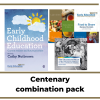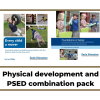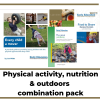Exploring the Wider World Project
The Exploring the Wider World Project was funded by the Stoke-on-Trent Opportunity Area and was delivered by Early Education between April 2019 and March 2020.
The direction of the project has been dictated by three key factors: a deep understanding of how young children learn best, developing sustainability for practice, and drawing on the rich cultural capital that is on offer in the locality.
Young children learn best through first-hand experiences in contexts that are meaningful and familiar to them. It is sometimes useful to think about concentric circles radiating out from the centre, with the child and their family being in the centre. For the context of this project, the closer the circle the more meaningful it will be to the child with experiences being based in environments that are familiar and local building up as they grow, develop, and mature to destinations that are further afield. Time passes differently for young children and long journeys can be challenging for them as well as for the adults who are taking them out. This does not need to limit the child’s life experiences in any way: instead, ensuring that both the journeys and destinations are developmentally appropriate, and offer a rich variety of learning opportunities, help to maximise the educative potential of such activities.
There is a truly rich heritage in Stoke to explore: the varied architecture both modern and old, the regeneration work, the communal works of art, the number of museums, the canal, the factories, the public open spaces, and the differences across the 6 towns all lend themselves to providing exciting and stimulating places for young children, their families, and carers to explore without having the challenge of long journeys. If children feel rooted in their present environment, they will branch out and take opportunities later on when a greater distance is more appropriate. To ensure sustainability, making use of what is available locally with little or no cost has been a priority, so that the children will enjoy greater learning opportunities beyond the lifespan of the project to leave a true legacy.
By offering experiences that children and families may not have had the chance to do before, they may be more likely to visit that place again or go somewhere else which offers a similar experience. An example of this is where a setting arranged to meet their families at the Potteries Museum and Art gallery. They arranged to meet there so that the children could be accompanied by the families and the visit then became the focus. None of the families had been to this museum before as they felt it wasn’t appropriate for them. The children and families focused this visit on looking at the works of art as they were going to hold their own exhibition as part of the end of year festivities. After the visit, all of the families reported that they now felt more confident to take their children there and that they would explore the other exhibits as well. They also felt that the exhibition which was put on later on in the term for the families at the setting was very like the experience that they had already had, and the families confidently talked about the similarities. Had this experience been offered further away families may have thought differently about attending and following up with further visits. The Experiences menu has been designed to support this – for example, whilst many children will have heard recorded music both at home and in the setting, they may never have heard a live performance by a tuned instrument, and this provides opportunities to enhance their lived experience in their locality.
The Exploring the Wider World Project was funded by the Stoke-on-Trent Opportunity Area and was delivered by Early Education between April 2019 and March 2020.
Rethinking our consideration of what an outing or a visit may be has been central to the project. Children need to build up their knowledge
Using the local environment enables children to develop a sense of belonging to the local community. It helps them to develop a sense of place
An early task for the Exploring the Wider World project was to identify the barriers to taking children out and about beyond the setting. Only
Risk is a natural part of our existence, as we look to explore and make sense of the world around us. What is key is
This page brings together all the key project elements of thinking through a trip or a visit in one handy place, with downloadable resources for
Meaningful learning opportunities relating to understanding the world rely on rich and stimulating resources. Consider what you have Rich and well thought out resources make
A reflection based upon rich and varied experiences of taking young children out into the Wider World by Kathryn Solly, Early Education Associate. Beginnings There
It is important to remember that the world of a 2-year-old is very different to ours. They are hugely fascinated by the things that we
By the time children get to be 3 years of age, they are, generally, better at walking and so can walk for longer periods of
Most 4-year-olds can walk faster and further than their younger counterparts. This means that they can venture further afield than the three year olds in
Walking is a great way to stay active for people for all ages. Particularly for children, walking: is fun and interesting – you get to
Using public transport can be really exciting for young children, especially for those who spend lots of time in cars, being ferried from place to
Social media is a powerful tool for sharing examples of good practice and celebrating achievements – but there potential pitfalls, particularly relating to consent. We
Since the introduction of the EYFS framework in 2008 there has been a huge emphasis upon encouraging parents to become engaged in their children’s learning.
This article by Early Education Associate Anni McTavish explores the term “cultural capital”, and what it might mean for early years practitioners and their settings.
Transition is part of the maturation process. Most children and their families find moving from one stage to the next seamless. Transitions need careful planning and will
We know young children appear to be starting settings with less developed language than in previous years due to a range of reasons. Understanding the









Early Education
2 Victoria Square
St Albans
AL1 3TF
T: 01727 884925
E: office@early-education.org.uk